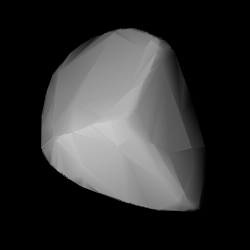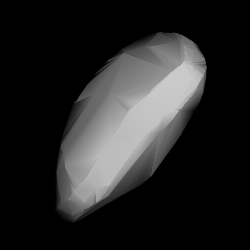2065 Spicer, provisional designation 1959 RN, is a dark and eccentric asteroid from the middle region of the asteroid belt, approximately 17 kilometers in diameter.
Lagrangea, provisional designation 1923 OU, is a carbonaceous background asteroid from the outer region of the asteroid belt, approximately 30 kilometers in diameter. It was discovered on 12 September 1923, by Russian astronomer Sergey Belyavsky at the Simeiz Observatory on the Crimean peninsula. The asteroid was named after Italian mathematician and astronomer Joseph-Louis Lagrange.
1151 Ithaka, provisional designation 1929 RK, is a carbonaceous asteroid from the inner regions of the asteroid belt, approximately 14 kilometers in diameter. It was discovered by Karl Reinmuth at the Heidelberg-Königstuhl State Observatory in 1929, and later named for the Greek island of Ithaca.
5318 Dientzenhofer, provisional designation 1985 HG1, is a stony background asteroid from the inner regions of the asteroid belt, approximately 6 kilometers (3.7 miles) in diameter. It was discovered on 21 April 1985, by Czech astronomer Antonín Mrkos at the Kleť Observatory in Bohemia, Czech Republic. The transitional S-type asteroid has a rotation period of 8.06 hours. It was named after the German Baroque architects Christoph and Kilian Ignaz Dientzenhofer.
1617 Alschmitt, provisional designation 1952 FB, is an assumed carbonaceous asteroid from in the outer parts of the main belt, approximately 30 kilometers in diameter. It was discovered on 20 March 1952, by French astronomer Louis Boyer at Algiers Observatory in Algeria, Northern Africa, and named after French astronomer Alfred Schmitt.
3567 Alvema, provisional designation 1930 VD, is a dark asteroid from the middle region of the asteroid belt, approximately 14 kilometers in diameter. It was discovered by Belgian astronomer Eugène Delporte at the Royal Observatory of Belgium in Uccle, on 15 November 1930. It was named after the discoverer's three great-granddaughters Aline, Vérionique and Martine.
1543 Bourgeois, provisional designation 1941 SJ, is a stony asteroid from the central asteroid belt's background population, approximately 12 kilometers in diameter. It was discovered on 21 September 1941, by astronomer Eugène Delporte at the Royal Observatory of Belgium in Uccle. The asteroid was named after Belgian astronomer Paul Bourgeois.
24101 Cassini (provisional designation 1999 VA9) is an eccentric background asteroid from the middle region of the asteroid belt, approximately 7 kilometers in diameter. It was discovered on 9 November 1999, by American amateur astronomer Charles Juels at the Fountain Hills Observatory (678) in Arizona, United States. It was named after Italian–French astronomer Giovanni Cassini.

1555 Dejan, provisional designation 1941 SA, is an asteroid from the background population of the central regions of the asteroid belt, approximately 22 kilometers in diameter. It was discovered on 15 September 1941, by Belgian astronomer Fernand Rigaux at the Royal Observatory of Belgium in Uccle. The asteroid was named after Dejan Đurković, son of Serbian astronomer Petar Đurković.
1184 Gaea, provisional designation 1926 RE, is an Aerian asteroid from the central regions of the asteroid belt, approximately 20 kilometers in diameter. It was discovered on 5 September 1926, by astronomer Karl Reinmuth at the Heidelberg-Königstuhl State Observatory in southwest Germany. The asteroid was named after the goddess of Earth, Gaea (Gaia), from Greek mythology.
14789 GAISh, provisional designation 1969 TY1, is a dark background asteroid from the outer regions of the asteroid belt, approximately 15 kilometers (9 miles) in diameter. It was discovered on 8 October 1969, by Soviet astronomer Lyudmila Chernykh of the Crimean Astrophysical Observatory at Nauchnij, on the Crimean peninsula. The assumed C-type asteroid has a rotation period of 8.1 hours and possibly an elongated shape. It was named for the Russian Sternberg Astronomical Institute (GAISh) of Moscow State University.
5385 Kamenka, provisional designation 1975 TS3, is a background asteroid from the outer regions of the asteroid belt, approximately 16 kilometers (10 miles) in diameter. It was discovered on 3 October 1975, by Soviet astronomer Lyudmila Chernykh at the Crimean Astrophysical Observatory in Nauchnij, on the Crimean peninsula. The presumed C-type asteroid has a rotation period of 6.68 hours. It was named for the Ukrainian town of Kamianka.
3785 Kitami, provisional designation 1986 WM, is a carbonaceous Themistian asteroid from the outer region of the asteroid belt, approximately 19 kilometers in diameter. The asteroid was discovered by Japanese astronomer Tsutomu Seki at Geisei Observatory on 30 November 1986, and named after the city of Kitami, Japan.
1412 Lagrula, provisional designation 1937 BA, is an asteroid from the inner regions of the asteroid belt, approximately 7 or 23 kilometers in diameter, depending on the body's divergent reflectivity measurements.

1361 Leuschneria, provisional designation 1935 QA, is a carbonaceous asteroid from the outer regions of the asteroid belt, approximately 30 kilometers in diameter. It was discovered on 30 August 1935, by Belgian astronomer Eugène Delporte at Uccle Observatory in Belgium, and named after American astronomer Armin Otto Leuschner.
3790 Raywilson, provisional designation 1937 UE, is a carbonaceous Themistian asteroid from the outer regions of the asteroid belt, approximately 12 kilometers in diameter. It was discovered on 26 October 1937, by astronomer Karl Reinmuth at the Heidelberg-Königstuhl State Observatory in Heidelberg, Germany. The C-type asteroid has a rotation period of 4.65 hours. It was named for English physicist Raymond Wilson.
2513 Baetslé, provisional designation 1950 SH, is a stony Flora asteroid from the inner regions of the asteroid belt, approximately 16 kilometers in diameter.
1511 Daléra, provisional designation 1939 FB, is an asteroid from the inner regions of the asteroid belt, approximately 12 kilometers in diameter. It was discovered on 22 March 1939, by French astronomer Louis Boyer at the Algerian Algiers Observatory, North Africa, and named after Paul Daléra, a friend of the discoverer.
10241 Miličević, provisional designation 1999 AU6, is a carbonaceous Themistian asteroid from the outer regions of the asteroid belt, approximately 11 kilometers (6.8 miles) in diameter. It was discovered on 9 January 1999, by Croatian astronomer Korado Korlević at the Višnjan Observatory in Croatia. The C-type asteroid has a short rotation period of 3.87 hours and was named after hermit and amateur astronomer Don Nikola Miličević.
12999 Toruń, provisional designation 1981 QJ2, is a carbonaceous Baptistina asteroid from the inner regions of the asteroid belt, approximately 8 kilometers in diameter. It was discovered on 30 August 1981, by British–American astronomer Edward Bowell at Lowell Observatory's Anderson Mesa Station in Flagstaff, Arizona, and named after the Polish city of Toruń.


